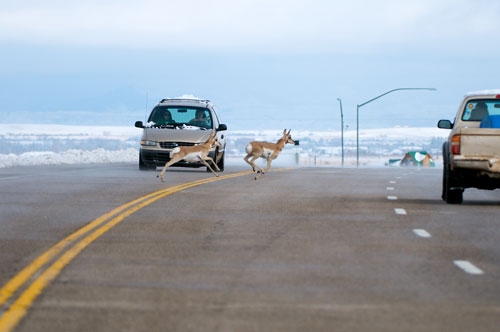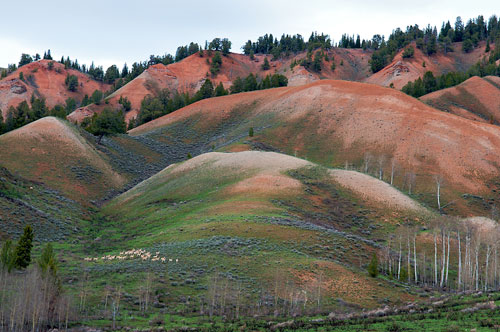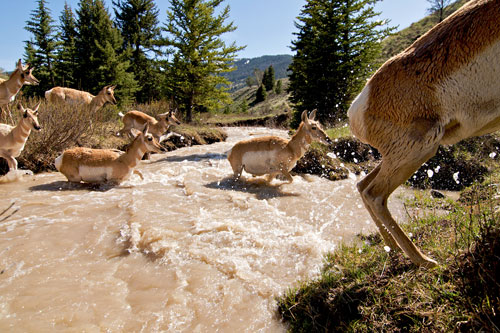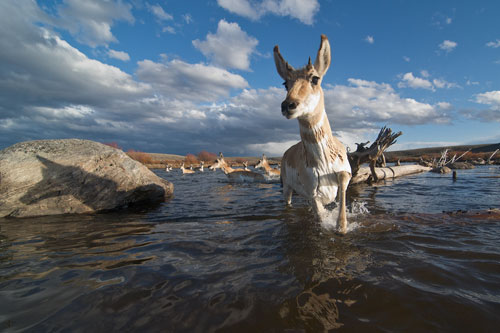
- A band of pronghorn, mainly does, migrating south for the winter. A herd of three hundred pronghorn spends its summers in Grand Teton National Park, and then each fall migrates into the Upper Green River Basin of Wyoming, a distance of about 150 miles. It is the second longest land mammal migration in the Western Hemisphere.
Time somehow collapses when you get out on the land in northwestern Wyoming, away from the scattered towns and tourist enclaves. Rhythms are old, eons old, geologic old. Five hundred million years ago these plains and basins were below the sea, and the high walls of the Tetons and Wind Rivers hadn’t yet thrust up from the Earth. Change here should be measured in millennia, not historic moments. But now, just a few decades can create upheaval, stuttering the natural pulse of the land, breaking its rhythms.
There’s no better place to see that than around Pinedale. A decade ago it was a small Western town where mom-and-pop diners served “homade” pies to locals, and outerwear stores served hikers heading into the Wind Rivers. Now Pinedale is a natural gas boomtown, its population more than double what it was in 2000, and the basin it sits in is punctuated by natural gas rigs and patchworked by new subdivisions. The human footprint is heavy here, so much heavier than that of the animals whose prints have churned up this dry soil for thousands of years. Human development has chopped the Western openness into fragmented parcels that block the routes deep set in the DNA of these animals, particularly the animals that migrate.
Ancestors of one of those migrators, the pronghorn, has been here tens of millions of years. It evolved to be fast. Fast enough to escape predators like saber-toothed tigers and cheetahs. Fast enough to rank as one of the swiftest land animals on Earth, clocking in at above 60 miles an hour. But speed is more handicap than asset in today’s West. “Prongies like to run quick and make turns this way and that,” says photographer Joe Riis. “When the land is fenced up into ranchette plots of 160 acres, for a prongie that’s equivalent to a human living in a closed-in concrete box.”
Having spent a year and a half following the Grand Teton herd, Riis probably knows them and their world as well as anyone.
Riis is a creature of open spaces himself, having grown up and still living on the Great Plains, near the Missouri River in South Dakota. There, the wind sweeps in tens of thousands of birds every November, and contemplating all those birds and where they go has made Riis sensitive to migration and movement. So he went looking for the animals that make one of the longest migrations in the Western Hemisphere, second only to the Arctic caribou—the 300 or so animals in the so-called Teton pronghorn herd. Every year they trek more than 150 miles from the Grand Tetons to their wintering grounds south of Pinedale.
The state claims as many pronghorn as people, about a half million total, but most pronghorn are sedentary and concentrated in the plains that stretch across the east-central part of the state. “Some of them don’t move more than a couple of miles a year,” Riis says, “but the Teton herd is always on the move.” And for fifteen months, Riis moved with them, documenting what’s become one of the most challenging migrations on the planet, thanks to the growing human obstacles in this coveted and burgeoning part of the state. But before Riis started photographing, he walked the migration path twice, once in the early summer, following the dried footprints left by the animals during the spring migration, and once during the fall migration. “I thought it was key to see the landscape the way the pronghorn do,” he says.
The herd spends the brief Wyoming summer grazing and foaling in the high meadows and forests of Grand Teton National Park—spectacular places whether you’re a pronghorn or a human. But snow comes early and unexpectedly to the high country, and the colder days are a signal to the pronghorn scattered through the park that it’s time to begin the long march back to their wintering grounds below Pinedale. There, they can paw through snow and graze on the sagebrush beneath it.

- This group of pronghorn tried to overwinter in Grand Teton and found itself in deep winter snows, forcing them south.
While Riis was covering the herd, though, one group of 74 animals stayed in the park far into the winter. “It wasn’t until mid-January, when the snow started to get really deep, that they finally decided to migrate,” he says. “I couldn’t get very far into the mountains, where I’d heard the band was. I could only ski in on day trips, looking for them, because I couldn’t carry both my camera gear and everything I’d need to survive overnight.”
On the third day he spotted them, barely moving because the snow was so deep. “For five more days, I skied back to them, and some of the days they could only move about a hundred feet. Prongies are hardly ever found in snow that deep, so I got some pretty unique shots, including pictures of fifty to seventy animals lined out in single file.”
Usually the migration south takes three to four days, but it took this band two weeks. Along the way, a couple of yearlings froze to the ground because it was so cold. And cold was only one of their obstacles. As with all of the pronghorn that make this migration, this group had to negotiate a manmade gauntlet that includes barbed wire fences. Pronghorn didn’t evolve to jump, so every time a fence blocks their path, they try to wedge themselves under it, a posture they’re clearly not built for. Some of them get snared by the barbed wire and don’t make it.
Fences can also make them easy prey. One morning Riis watched from the cabin of friends as three wolves took down five pronghorn. “The snow was deep and the pronghorn were punching through when a fence stopped them,” he says. “The wolves had them cornered. After they had their fill and left, several coyotes came to finish the feast, along with eagles and a lot of ravens. The pronghorn probably saved some of those animals. It was amazing to watch that drama unfold. I didn’t even think about getting my camera out.”

- A band of southbound pronghorn stoop under a barbed wire fence. Pronghorn are not adapted for leaping, and many are entangled in fence lines each year.

- Pronghorn crossing Highway 191 near the town of Pinedale, Wyoming. Conservationists hope to build a wildlife overpass.
The most challenging part of the Teton herd’s migration has to be Highway 191, the main north-south route through this part of the state. At a historic bottleneck called Trapper’s Point, the Green and New Fork Rivers force the pronghorn into a quarter-mile wedge. Paleo- Indian hunters must have positioned themselves at this chokepoint because fossilized bones of butchered pronghorn, dating back six thousand years, have been recovered here. Ancient pronghorn had the chance of outrunning their hunters, but today’s pronghorn, funneled from the mountains to the lip of the roadway, are outmatched by speeding cars and big rigs. Their protection rests on the caution of passing drivers—and the efforts of conservationists, who are seeking to reconnect their fragmented migratory route.
In 2008, the Wyoming Department of Transportation built a series wildlife underpasses at places where fence lines had been forcing pronghorn toward the highway. The underpasses helped some, but most pronghorn were too skittish to enter the dark, narrow tunnels. Last Earth Day, Congressional Democrats introduced the Wildlife Corridors Conservation Act to build highway overpasses, covered with earth and natural vegetation, at Trappers’ Point and other migratory paths around the country—but that legislation, to date, is languishing in committee. So, for now, pronghorn have to count on their own speed to survive—and maybe, too, on what Joe calls their “prehistoric knowledge.”
“The Teton prongies are different from other wildlife I’ve photographed,” he says. “They have a sense of grace in them. It seemed like they always knew what I was going to do, or proposing to do, when I was near them with my long lens. I only caught them off guard when I used camera traps and they didn’t realize they were being photographed. That’s when I captured some intimate moments.”
He used a camera trap to get the image he’s most pleased with, showing the animals crossing the Green River during the spring migration. “Luckily, the spring migration happens over two months, with short migration pulses throughout. That gave me a lot of chances to get the shot I wanted of the animals facing the camera, with the river in the background.
“I worked with a young woman in the area, Callie Domek, who knows the wildlife as well as anyone. She and I figured out exactly where the prongies cross, and we spent six weeks there. I moved and tweaked the camera probably ten times before everything finally came together— evening light, the expression on the lead doe’s face, and her shadow on a rock in the river.”
Riis says the migrating pronghorn have a determined look on their faces and move “almost like they’re gliding along. I think that’s because when they’re migrating they don’t make any extra motions that use energy—all the energy they output results in miles moved. And the bucks are never in front. Old does almost always lead the way. I don’t think the bucks really know where they’re going; they’re just following the does, who know exactly what they’re doing. When the spring green-up starts, they can envision that lush heaven of a place up in the Tetons and they head that way. I think the does teach the migration to their daughters. That may just be me talking, but after watching them, that’s how I feel.”
Having spent a year and a half following the Teton herd, Riis probably knows them and their world as well as anyone. “I want to live in a biodiverse world,” he says, “and for that to happen, people have to value wild animals. They need a voice that humans can understand, and wildlife photojournalism can give them that voice. That’s why I did this project, to help people visualize what it’s like to be a migrating animal, to be a pronghorn in today’s world.”
K. M. Kostyal is the author of numerous volumes for National Geographic Books. Her most recent, Great Migrations, featured three of Joe Riis’s pronghorn photographs.
1 Comments
Thank you to both Ms Kostyal and Mr Riis for "valuing wild animals" and "giving them a voice" so as to preserve the biodiversity in our world. What a wonderful piece this is!
Man-made wildlife crossings are the way to go; many can be seen as you drive in the Banff and Jasper National Parks in Alberta, Canada. I would urge legislators in the USA to get it done ASAP!














